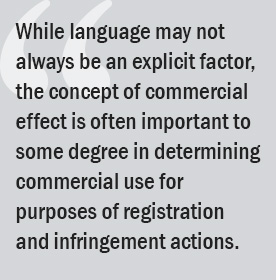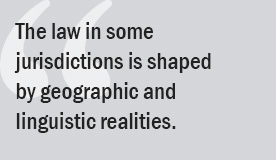INTA News
Cross-Border ‘Bleed Over’ in Advertising and Availability of Trademarks on the Internet
Published: April 15, 2019
Jenna P. Torres Eckert Seamans, Cherin, & Mellott, LLC White Plains, New York, USA
Matthew Frederick Reed Smith Pittsburgh, Pennsylvania, USA
Micheline Johnson Baker Donelson Memphis, Tennessee, USA Emerging Issues Committee
 The Territorial Limits and Fair Use (TLFU) Subcommittee of the Emerging Issues Committee has investigated the following questions regarding what is considered fair use or actionable use of a trademark:
The Territorial Limits and Fair Use (TLFU) Subcommittee of the Emerging Issues Committee has investigated the following questions regarding what is considered fair use or actionable use of a trademark:
- Is a brand considered “used” in every jurisdiction that can receive an electronic transmission advertising a particular brand (for example, over satellite television, the Internet, mobile device, or industrial, scientific, and medical-ISM-radio band) even if there are no sales or distribution of goods or services?
- What is the extent of fair use in this situation? Is cross-border comparative advertising actionable?
- Can use be established through cross-border advertising, and is such use actionable as trademark infringement?
Not surprisingly, the answer to all of these questions is, “It depends.” The TLFU Subcommittee members collected information from a representative sample of countries to determine the current status of the law regarding these “bleed over” situations, including Australia, Canada, Chile, China, Colombia, Germany, India, Israel, Japan, the Republic of Korea, Mexico, New Zealand, Taiwan, the United Arab Emirates, the United Kingdom, the United States, and Uruguay. The commercial effect of the advertisement or transmission plays a role in most jurisdictions in determining use and infringement of a mark-but there are many other factors at play.
Language May Be Key
The law in some jurisdictions is shaped by geographic and linguistic realities. In Japan, for instance, bleed over in advertising is not an issue because Japan is surrounded by countries whose inhabitants speak languages other than Japanese. As a result, the primary factor in Japan for whether or not an advertisement or transmission will be considered use of a trademark is whether or not the advertisement is in Japanese.
Germany, the Republic of Korea, and the United Kingdom all use language as a factor in determining use of a trademark in those jurisdictions. This is because language is an essential part of the question of the trademark’s commercial effect, namely, are consumers in a certain jurisdiction being targeted by the advertisement or transmission?
Other factors that are used to determine whether consumers are being targeted include local shipping and currency options, the inclusion of a local telephone number, and testimonials of local customers. In these jurisdictions, the mere availability of an advertisement is not sufficient to establish use. In India, in 2018, these indications of goodwill and reputation were explicitly required when the courts rejected Toyota KK’s claim of trademark infringement against Prius Automotive Ltd. for the PRIUS trademark.
Commercial Effect Is Context Dependent
While language may not always be an explicit factor, the concept of commercial effect is often important to some degree in determining commercial use for purposes of registration and infringement actions.
 In some instances, such as in India and the United Arab Emirates, mere accessibility of a website or transmission to consumers in those countries could be considered use for defensive purposes. However, in order to prove use to rise to the level of infringement, factors of commercial effect, goodwill and reputation, and the extent and nature of transactions with consumers will be considered. Language plays a lesser role in the analysis in these jurisdictions, given the linguistic complexity of the countries and their widespread use of English.
In some instances, such as in India and the United Arab Emirates, mere accessibility of a website or transmission to consumers in those countries could be considered use for defensive purposes. However, in order to prove use to rise to the level of infringement, factors of commercial effect, goodwill and reputation, and the extent and nature of transactions with consumers will be considered. Language plays a lesser role in the analysis in these jurisdictions, given the linguistic complexity of the countries and their widespread use of English.
In some countries, “real and effective use” requires that a product or service that bears a certain mark be commercialized, and not just accessible, in that country. Countries such as Colombia and Uruguay require trademark owners to prove sales to its consumers or exports from those countries as evidence of use of a mark.
Asian jurisdictions such as China, Japan, South Korea, and Taiwan are areas that adhere to a strict interpretation of territoriality and commercial effect. Use on the Internet or over a satellite transmission may be considered use for certain purposes if a website offers goods or services in local language, provides local contacts and support, and allows payment in local currency. However, it will not be considered use for infringement purposes unless the domain address originates from within the jurisdiction. Where the local authorities have no power to prevent infringement, there is no point in deeming such use as infringement.
Certain Borders Are More Complicated Than Others
As one might imagine, the long border between Canada and the United States-two countries that share a common language and many ISM transmissions-makes for some interesting case law. The cases that deal with questions of fair use are fact-intensive, and depend on the nature of the good or service and how it becomes available to those across the border. For example, advertising spillover into Canada from the United States in general is not considered use, and as a rule is not actionable as infringement. However, a Canadian federal court found that AT&T could prove use of its trademark in Canada for prepaid telephone services because Canadians could activate these services from Canada, even though the services were not sold in Canada. AT&T Intellectual Property II, L.P v. Lecours Herbert avocats Inc., 2017 FC 734.
On the other side of the border, a U.S. federal appeals court determined that a Canadian defendant could face civil claims for trademark infringement based on his actions in transporting Trader Joe’s‒branded goods to Canada and reselling them as “Pirate Joe’s.” Trader Joe’s v. Hallatt, 835 F.3d 960 (9th Cir. 2016).
Navigating the Unknown
If a particular jurisdiction has no legal guidance on the question of local use from ISM transmissions, the TLFU Subcommittee recommends the below factors be evaluated in order to argue for or against the commercial effect of such use:
- The language used in the advertisement compared to that of the local population;
- The advertisement’s inclusion of:
- Local currency and shipping options;
- Local contact and support; or
- Posted testimonials of local customers
- The trademark’s goodwill and reputation in the country;
- The extent and nature of transactions with domestic customers;
- The nature of the goods or services and how available the goods or services are across the border; and
- The sales to its consumers, or exports to them.
Although every effort has been made to verify the accuracy of items in the INTA Bulletin, readers are urged to check independently on matters of specific concern or interest.
© 2019 International Trademark Association